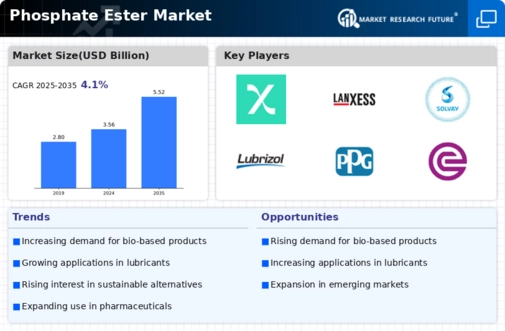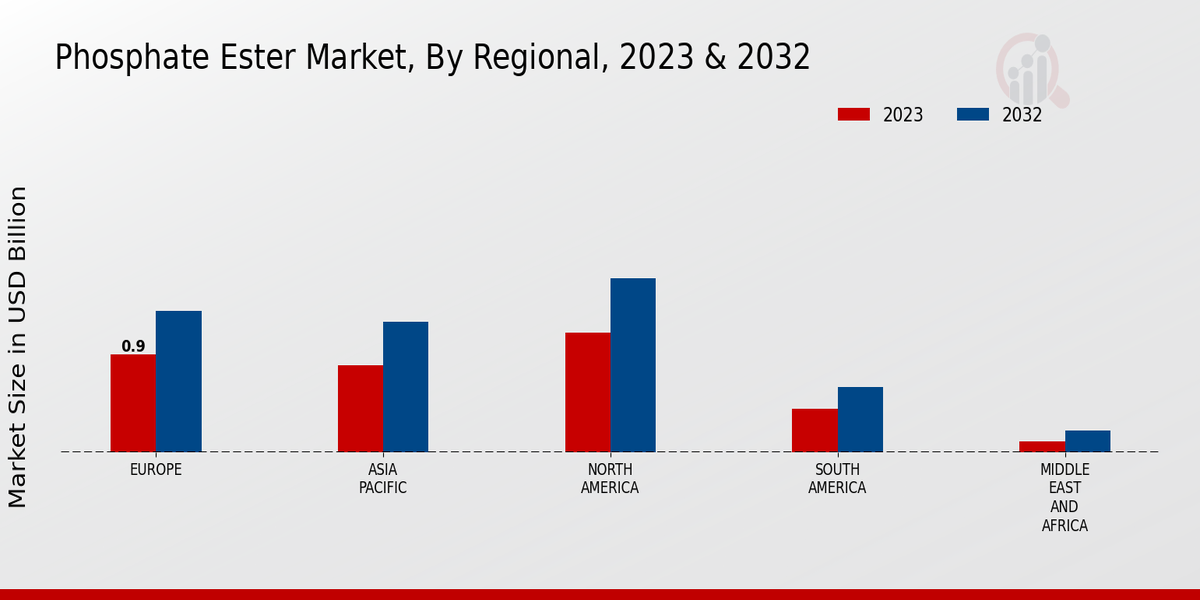Market Growth Projections
The Global Phosphate Ester Market Industry is projected to experience substantial growth over the next decade. With a market value expected to reach 3.56 USD Billion in 2024 and an anticipated increase to 5.52 USD Billion by 2035, the industry is on a promising trajectory. The compound annual growth rate of 4.06% from 2025 to 2035 indicates a steady expansion, driven by diverse applications across various sectors. This growth is likely to be influenced by factors such as technological advancements, regulatory support for eco-friendly products, and increasing demand in automotive and personal care industries.
Expansion in Industrial Applications
The Global Phosphate Ester Market Industry is witnessing significant expansion in various industrial applications, including metalworking fluids and hydraulic fluids. These esters are favored for their excellent lubricating properties and ability to function under extreme conditions. Industries such as aerospace and manufacturing increasingly rely on phosphate esters to enhance operational efficiency and equipment longevity. The anticipated growth of the market to 5.52 USD Billion by 2035 suggests a sustained interest in these versatile compounds. Furthermore, the compound's biodegradability aligns with global sustainability initiatives, making phosphate esters a preferred choice in environmentally conscious industries.
Rising Demand in Personal Care Products
The Global Phosphate Ester Market Industry is experiencing a rising demand in the personal care sector, where these compounds are utilized as emulsifiers and surfactants. Phosphate esters are valued for their ability to stabilize formulations and enhance product performance in cosmetics and skincare products. As consumer preferences shift towards high-quality, effective personal care items, the demand for phosphate esters is expected to grow. This trend aligns with the overall market growth, projected to reach 3.56 USD Billion in 2024. The increasing focus on natural and sustainable ingredients further supports the adoption of phosphate esters in personal care formulations.
Technological Advancements in Production
Technological advancements in the production of phosphate esters are playing a crucial role in shaping the Global Phosphate Ester Market Industry. Innovations in synthesis methods and processing techniques are enhancing the efficiency and cost-effectiveness of phosphate ester production. These advancements not only improve product quality but also expand the range of applications for phosphate esters across various sectors. As manufacturers adopt these new technologies, the market is poised for growth, with projections indicating a rise to 5.52 USD Billion by 2035. This evolution in production capabilities is likely to attract new players and foster competition within the industry.
Growing Demand in Automotive Applications
The Global Phosphate Ester Market Industry experiences a notable surge in demand driven by the automotive sector. Phosphate esters are increasingly utilized as additives in engine oils and lubricants, enhancing performance and reducing wear. As the automotive industry evolves towards more efficient and environmentally friendly solutions, the adoption of phosphate esters is likely to rise. This trend is underscored by the industry's projected growth, with the market expected to reach 3.56 USD Billion in 2024. The shift towards electric vehicles and stringent emission regulations further propels the need for advanced lubricants, indicating a robust future for phosphate esters in automotive applications.
Regulatory Support for Eco-Friendly Products
Regulatory frameworks worldwide are increasingly favoring eco-friendly products, which significantly impacts the Global Phosphate Ester Market Industry. Governments are implementing stringent regulations to limit the use of harmful chemicals, thereby promoting the adoption of phosphate esters due to their lower toxicity and environmental impact. This regulatory support is likely to drive market growth, as manufacturers seek compliant alternatives for their formulations. The projected compound annual growth rate of 4.06% from 2025 to 2035 indicates a robust market trajectory, as industries adapt to these regulations and prioritize sustainable practices in their operations.











